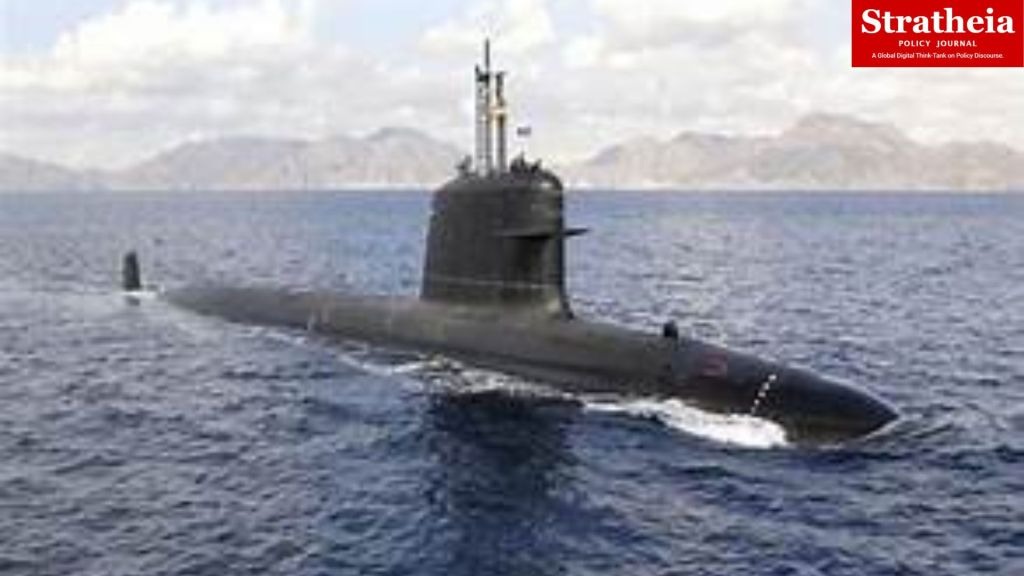The traditional concept of nuclear deterrence, which is based on mutual vulnerability, is weakening due to the rapid advancement of strategic non-nuclear weapons (missile defense system, cyber tools, AI, and quantum technology). Today, land based nuclear weapons are increasingly vulnerable to an adversary’s ballistic missile systems, cyber tools, and quantum technology. These emerging technologies pose serious threats to land based nuclear weapons. To cope with it, nuclear-powered ballistic missile submarines (SSBNs), a sea-based deterrents, are becoming the assured leg of a nuclear triad. In this context, India is building a robust SSBNs fleet as a strategic response to achieve a nuclear triad. These SSBNs fleet demonstrates that India’s strategic ambitions reach beyond South Asia.
Presently, New Delhi operates two SSBNs: INS Arihant and INS Arighaat, and the third INS Aridhaman (S4) is expected to join the fleet later this year. The Indian SSBNs are dedicated to maintaining deterrence not only in South Asia but far beyond. The Arihant class, followed by Arighaat and Aridhaman, can carry nuclear-armed missiles such as K-4, and K-15 that have a target range of 3500km and 750 km respectively. This submarine race by India is aimed at countering not only Pakistan but China as well. India is developing k-5 missiles, the variant of K series missile, which have target range of around 6000km. It will be upgraded into K-6 missiles with a range of 8000km, with speed of 7.5 Mach. It is widely speculated that the upcoming advanced variants of K series missiles might hit at a range of 10000km as India has already developed Intercontinental Ballistic missiles such as Agni-V and Agni VI which can hit the target up to the ranges of 12000km. This is evident that India’s strategic doctrine is not limited to South Asia but extend to Europe, America and the entire Asia-Pacific region.
These SSBNs can carry Multiple Independent Targetable Re-entry Vehicle (MIRV) payload, which means that a single missile can strike multiple targets with separate warheads. The upcoming K-5 and K-6 are deployed on India’s nuclear powered ballistic missiles submarine (SSBNs) like the Arihant class or the upcoming S5, they can be fired from far-off in the ocean. They can not only target Pakistan and China, but also Europe, Russia, Africa, and some parts of the United States, including the Pacific region.
The Indian SLBMs, with intercontinental reach, reflects Indian global strategic design. The SSBNs provide an assured and credible platform for launching nuclear strikes, due to their stealth nature, and prolonged ability to remain at sea. The integration of its third nuclear-powered ballistic missile submarines (SSBN), INS Aridhaman (S4), demonstrates that India is swiftly catching up with the world’s advanced and superior naval powers such as United States (US), China, and Russia. It is understood that the India SSBMs program is designed not solely to project nuclear deterrence in the Indian Ocean region and beyond also. It reflects the India’s global strategic ambitions, to become a global nuclear power, enabling to exert nuclear deterrence at intercontinental ranges. Therefore, the development of K-6 missiles with range of 8,000km and with estimated speed of 7.5 Mach, underlines that India is trying to match its naval prowess with the global powers like US and China.
Ironically, this intercontinental reach of the Indian SLBMs has been supported by the championed of non-proliferation such as the US, France, and Russia by underpinning defense ties with India. Moreover, despite India’s free access to sensitive propulsion and guidance technology, the Missile Technology Control Regime (MTCR), to which India is signatory, is continuously supporting India rather than restricting its actions. Because of this unconditional and irresponsible support to India by the great powers, India’s quest for becoming part of the global intercontinental missiles countries is not abated and continues to acquire the advanced missile technologies like the hypersonic technologies and MIRVs. Under these circumstances, it is incumbent on the international community to take note of this aspect of India’s sea-based deterrence and recalibrate relationships with New Delhi accordingly.
In contrast, Pakistan is always subjected to unfounded allegations by the US government, for developing intercontinental ballistic missiles. Pakistan’s missiles program is exclusively India-centric, with the longest-range missile Shaheen-III of having 2750km range. This mistreatment of the US encourages India’s global strategic objectives on one hand and affects Pakistan’s action as a responsible nuclear power state on the other hand.
The implications of these submarines for regional countries, like Pakistan and China, are manifold. Considering the recent India-Pakistan conflict and previous standoff, Pakistan is already grappling with India’s irrational, irresponsible and jingoistic behavior. For its own defense, Pakistan is likely to pursue anti-submarine warfare (ASW) capabilities to deter India’s naval misadventure in the future. Furthermore, India’s advancement may induce Pakistan to enhance its strategic non-nuclear weapons capabilities such as missiles defense system, cyber tools, AI, quantum tech and ASW, as well as improving its own sea-based deterrence to counter the perceived threat from India’s SSBNs. Lastly, India’s SSBNs program clearly contradicts its professed policy of No-First Use (NFU). The deployment of nuclear weapons at sea demonstrates that India could potentially initiate a first nuclear attack. The independent command and control system of SSBNs increases the risk of preemptive nuclear attack, particularly during the crisis by misjudging the adversary’s action. Consequently, the existence of these SSBNs undermines escalation control and crisis management by producing new variables that could result in miscalculation. In a nutshell, India’s SSBNs program displays its obvious disregard of regional deterrence thinking and demonstrates its ambitions to become a global nuclear power. The deployment of sophisticated weapons such as SLBMs with MIRVs of long-range, on SSBNs clearly shows that India intends to continue aggressive posture not only in South Asia but across the world.
This article was published in another form at https://stratheia.com/why-indias-ssbns-have-global-reach/
Mr Murad Ali is a Research Officer at Center for International Strategic Studies (CISS), Islamabad

